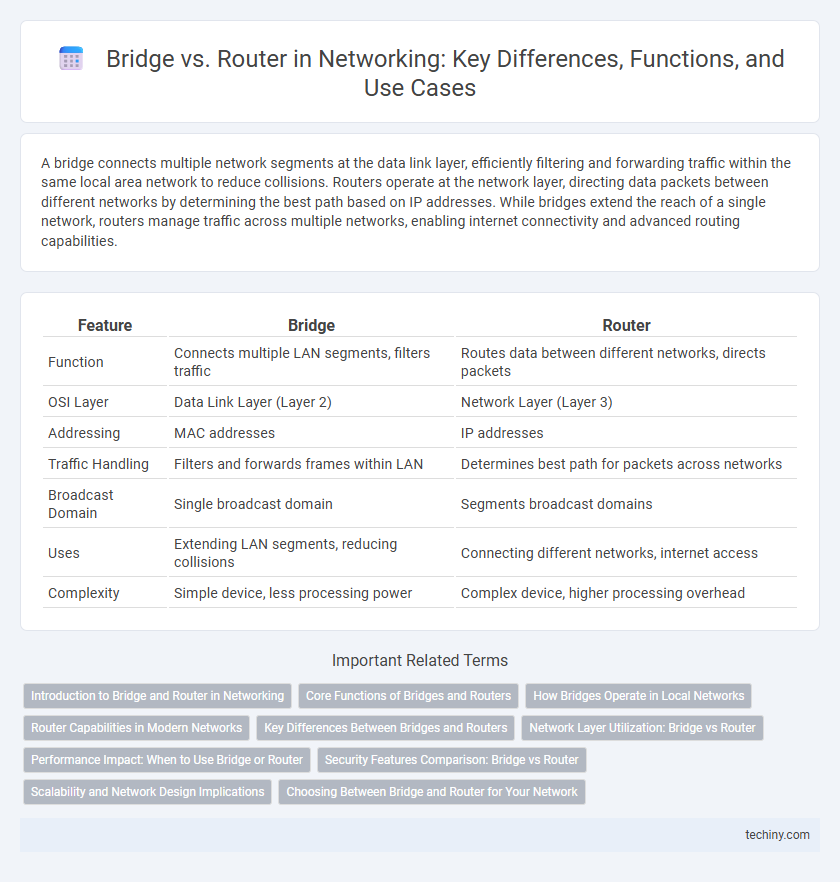A bridge connects multiple network segments at the data link layer, efficiently filtering and forwarding traffic within the same local area network to reduce collisions. Routers operate at the network layer, directing data packets between different networks by determining the best path based on IP addresses. While bridges extend the reach of a single network, routers manage traffic across multiple networks, enabling internet connectivity and advanced routing capabilities.
Table of Comparison
| Feature | Bridge | Router |
|---|---|---|
| Function | Connects multiple LAN segments, filters traffic | Routes data between different networks, directs packets |
| OSI Layer | Data Link Layer (Layer 2) | Network Layer (Layer 3) |
| Addressing | MAC addresses | IP addresses |
| Traffic Handling | Filters and forwards frames within LAN | Determines best path for packets across networks |
| Broadcast Domain | Single broadcast domain | Segments broadcast domains |
| Uses | Extending LAN segments, reducing collisions | Connecting different networks, internet access |
| Complexity | Simple device, less processing power | Complex device, higher processing overhead |
Introduction to Bridge and Router in Networking
A bridge in networking connects two or more network segments at the data link layer (Layer 2) to filter traffic and reduce collisions by forwarding data based on MAC addresses. A router operates at the network layer (Layer 3), directing data packets between different networks using IP addresses to manage traffic efficiently and enable communication across diverse network architectures. Bridges primarily extend a single network by segmenting it, while routers connect multiple distinct networks, enabling internetwork communication.
Core Functions of Bridges and Routers
Bridges operate at the data link layer (Layer 2) to filter traffic by MAC addresses, reducing network collisions and segmenting local area networks (LANs). Routers function at the network layer (Layer 3), directing data packets between different networks based on IP addresses, enabling communication across diverse subnetworks. While bridges primarily connect and manage traffic within the same network segment, routers facilitate inter-network connectivity and path selection for optimal data delivery.
How Bridges Operate in Local Networks
Bridges operate in local networks by filtering and forwarding data frames based on MAC addresses, effectively dividing the network into segments to reduce collision domains. They inspect incoming traffic and determine whether to forward or block it, which optimizes bandwidth and minimizes congestion within LAN segments. By operating at the data link layer, bridges facilitate smooth communication between devices in the same local network while preserving network efficiency.
Router Capabilities in Modern Networks
Routers in modern networks manage traffic between multiple IP networks by analyzing packet headers and making dynamic routing decisions based on protocols such as OSPF, BGP, and EIGRP. They enable network segmentation, support VLANs, provide NAT services, and integrate security features like firewalls and VPNs for secure data transmission across diverse network environments. High-performance routers optimize bandwidth usage and reduce latency, essential for scalable enterprise and cloud network infrastructures.
Key Differences Between Bridges and Routers
Bridges operate at the data link layer (Layer 2) to filter traffic by MAC addresses within a single network segment, whereas routers function at the network layer (Layer 3) to route data packets between different networks using IP addresses. Bridges reduce collision domains and manage traffic within LAN segments, while routers connect multiple LANs or WANs, performing traffic direction and enabling inter-network communication. Routers support advanced features such as network address translation (NAT), firewall functions, and dynamic routing protocols, which bridges do not typically provide.
Network Layer Utilization: Bridge vs Router
Bridges operate primarily at the Data Link Layer (Layer 2), filtering traffic within a single network segment by using MAC addresses, which limits their ability to manage traffic across different networks. Routers function at the Network Layer (Layer 3), utilizing IP addresses to route data packets between multiple networks, enabling efficient traffic management and network segmentation. Network layer utilization in routers supports complex routing protocols like OSPF and BGP, which optimize data paths and enhance overall network performance compared to bridges.
Performance Impact: When to Use Bridge or Router
Bridges operate at the data link layer and efficiently filter traffic within the same network segment, minimizing latency and reducing collision domains for small to medium-sized LANs. Routers manage traffic between different networks at the network layer, providing advanced routing, security, and traffic management but introducing higher processing overhead and latency. Use bridges to enhance performance in simple, flat networks; opt for routers to optimize bandwidth and control in complex, segmented network architectures.
Security Features Comparison: Bridge vs Router
Routers provide advanced security features such as built-in firewalls, Network Address Translation (NAT), and Virtual Private Network (VPN) support, which enable effective control over data traffic and enhanced protection from external threats. Bridges operate mainly at the data link layer, lacking these comprehensive security mechanisms, making them more vulnerable to attacks like MAC spoofing and unauthorized access. Network administrators often prefer routers for environments demanding robust security due to their capability to enforce access control lists (ACLs) and packet filtering.
Scalability and Network Design Implications
Routers offer superior scalability compared to bridges by efficiently managing traffic between multiple networks through IP routing, supporting larger and more complex network designs. Bridges operate at the data link layer, limiting them to smaller, simpler network segments and causing potential performance bottlenecks as network size grows. Network design incorporating routers allows for better segmentation, traffic control, and integration of diverse network protocols, crucial for expanding enterprise environments.
Choosing Between Bridge and Router for Your Network
Selecting between a bridge and a router for your network depends on the network size and traffic management needs. Bridges are ideal for connecting smaller, similar network segments by filtering traffic at the data link layer, while routers excel in directing data packets between different networks using IP addresses. For complex networks requiring inter-network communication and advanced security features, routers provide enhanced control and scalability compared to bridges.
Bridge vs Router Infographic

 techiny.com
techiny.com